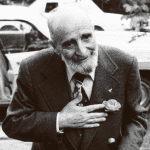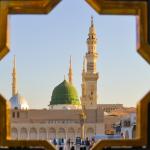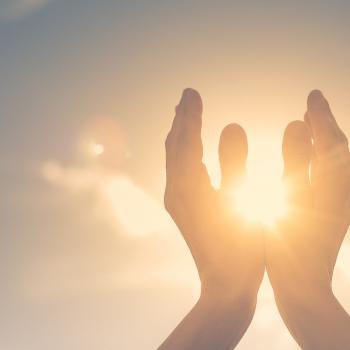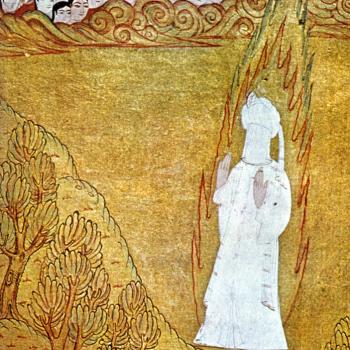Whirling is a seven-centuries old form of full-body worship emblematic of the Mevlevi tradition of Jalaluddin Rumi — and a practice I’ve woven into my spiritual routine over the past couple of years. Each time I begin whirling, there are a few moments my mind’s eye lingers in the image of a flower sprouting from the soil and slowly growing, budding and opening into full bloom.
Also known as turning, it begins by tilting the head toward the heart and crossing the arms at the chest, right over left, with the fingers wrapped slightly over shoulders. After bowing down before my teachers in the Seen and Unseen, I rise upright into a shape resembling the Arabic letter Alif and start rotating counterclockwise. Slowly, I uncross my arms and glide my fingers down the centre of my body toward my belly, as though a seed is being planted in the root of my being.
Then, again slowly, I move my fingers back up over my solar plexus and past my heart before outstretching my arms into the air, as though they are spreading out like the petals of a flower opening into its full splendour. This flower is swaying in the breeze, delighting passers-by with its fragrance and, all the while, firmly rooted in the Earth.
This image reminds me that with all the beauty of movement embodied by whirling, it is most importantly about grounding. It took me a long time to understand this. I recall the first time I saw whirling dervishes during my first visit to Istanbul in 2010. My sister and I saw a pair of them spinning counterclockwise in their white, flowy gowns at a restaurant near the Blue Mosque. I felt dizzy just watching them and assumed that this “dance” transported the dervish into some trance-like, ecstatic state.
My experience with the Mevlevi form of whirling has been quite the opposite: It is while turning that I feel the most rooted in my body. This has been an important teaching for me. As someone with an active connection to the imaginal realm, I can easily lose touch with the anchor of my body. I have a tendency to forget to breathe deeply and at times entirely detach from the sensations of my gut, legs and feet.
By engaging every part of my physical form with each 360-degree rotation, whirling strengthens my core, improves my balance and enhances my awareness of the Heart, the dimensionless point in the centre of my being where I am closest to Allah.
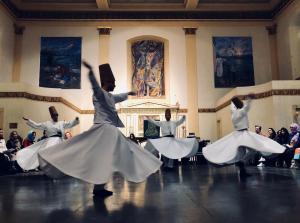
In order to turn gracefully, the dervish’s left leg must be fixed on the floor, which in practice I find hard to do. It feels something like trying to embody Al Qayyum, the Quality of the Divine that means the Self Subsisting Source of All Being. My shaikh has likened Al Qayyum to a pole connecting the world of Spirit and the earthly realm, crossing through the human heart. The more centred I become, the more my left leg can hold position. The opposite is also true. If I get caught in the chatter in my mind, my body wobbles.
The right leg, meanwhile, rotates around the left, much like the embodiment of the Divine Name Ya Hayy, the Ever Living One. This interplay between Ya Qayyum (axis) and Ya Hayy (motion) is a constant reminder that life flows most beautifully from solid roots.
This anchoring is crucial because the dervish straddles the Unseen and the Seen realms. The right arm is directed toward the sky, with the palm cupped upward to receive seeds of blessings from the world of Spirit. These blessings pass through the heart and are dispersed through the left palm arched downward, like a spout scattering the seeds into the earthly realm. The whirling dervish’s face, tilted toward the left hand, is a symbol of the importance of rooting oneself in this world.
Whirling unites the mind, heart and body in a way that no other form of worship achieves for me. Sometimes in the midst of turning for a long time, I feel as though my body and mind are revolving around my heart, like planets orbiting the sun. They all engage in the practice, surrendering to the motion of the universe and the knowledge that the heart is the portal to Haqq, Truth.
It’s remarkable to reflect on how far I’ve come. When I started learning how to turn, my body would revolt with bouts of uncomfortable nausea and vomiting. My mind, meanwhile, would protest that spinning in circles was difficult and I shouldn’t bother trying.
Yet amid the noise of both was my heart’s palpable yearning to learn this beautiful form of embodied zikr, remembrance of Allah, the Divine Reality. This longing, coupled with the will to keep trying, eventually brought the hesitations of my mind and body to rest.
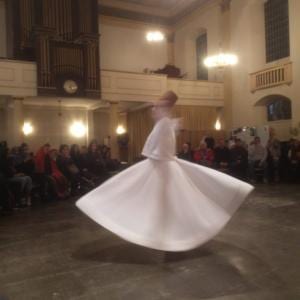
Now my mind and body are aligned with my heart — they also love to turn. There is no nausea, in fact motion sickness has almost entirely disappeared from my life. Instead, there is deepening sense of unity of these three elements of human nature in surrendering to immense joy, which calls to heart the lines of a Turkish devotional song played during Sema, the whirling dervish ceremony:
Sema safa, jana shifa, ruha gıdadır
Sema is joy, remedy for the soul, food for the spirit
Sema, which derives from the Arabic word meaning to listen, is very much about listening within. It is a form of zikr that enhances my attunement with the sensations, thoughts, emotions and feelings passing through my body. Witnessing their movement from my inmost centre guides me to the beliefs that are blocking the natural flow of life.
It’s as though the act of whirling not only moves the body but shakes the psyche. It brings the false beliefs lurking in the shadows into the light of conscious awareness, dissolves their knots and allows me to slowly live in greater harmony with the Love of Allah, whose Name is held in my heart with every rotation.
This process of taming the ego is represented beautifully in the clothing the whirling dervish wears. The camel’s hair hat (sikke) represents the tombstone of the ego, while the wide, white skirt (tennure) represents the ego’s shroud. By removing the black cloak (khirka), the dervish is spiritually reborn to the Truth. The black belt wrapped around the waist represents the letter Alif, testifying to the unity of the Divine. Worn over the tennure is a short, white, long-sleeved, collarless jacket called a dasta-gul, a “bouquet of roses.”
In the beauty of its form and its spiritual and physical benefits, whirling is most of all about emptying of everything that isn’t Love. The emptier I become of the distractions of the ego self, the easier it becomes to spin on my axis and the more baraka (blessing) can move from Love through my heart. For me, I feel the pull to serve the calling of this Love through writing poetry, song lyrics and stories and using my voice to sing and recite Quran.
In the words of my beloved murshid, Kabir Helminski, the whirling dervish becomes a vortex. She is drawn to her inmost centre and is aware of her heart connection to her shaikh, who holds the transmission of the lineage back through Rumi, Prophet Muhammad, peace and blessings be upon him, and ultimately to Allah.
The more she practices, the better able she is to carry this connection into every situation of life. She becomes much like the image of the flower in my mind’s eye, blossoming slowly into her full, radiant potential.
“It can only be done,” Dede says, “with that emptiness that is both presence and remembrance. And when you can do that, you can enter into the chaos of life as if you’re whirling through life.”

